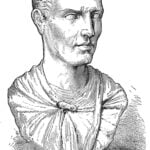Sergius Orata was an entrepreneur whom Pliny the Elder mentions several times in his work Natural History. On the basis of these mentions, some researchers concluded that Orata was the inventor of the so-called hanging baths, which were equated with the system of heating the floor and swimming pools in baths – hypocaustum. Nothing could be more wrong. Hypocaustum is a Greek invention, only slightly improved by the Romans, while Sergius Orata was a fish farmer and it was in this field that he was an innovator.
We do not know the years in which Sergius Orata lived, but it is known that his activity peaked in the 90s of the 1st century BCE. It is believed that through the famous rhetoric and consul from 95 BCE Lucius Licinius Crassus, had the opportunity to meet the famous Greek physician Asclepiades from Bithynia (specifically from Prussia, today Bursa in Turkey), who lived and worked in a similar period. Pliny the Elder reports that Orata was the inventor of hanging baths – bal(i)nea pensilia. We can find similar information in Valerius Maksymus (1st century BCE), but here the Polish translator Ignacy Lewandowski translated balinea pensilia as hanging bathtubs, which seems to be a more adequate translation.
What exactly was balinea pensilia? Sergius Orata was a fish farmer, so his invention had to be somehow related to this industry. The word pensilia means not only hanging but also suspended, in other words, something that is upstairs, such as hanging gardens. This term appears in the sources also in the context of walking on the highest ledge from which one could admire the seashore. Therefore, it is assumed that Orata devised special terraced ponds for fish farming where water cascaded from one reservoir to another. Research has shown that most of the artificial fishponds in Italy are built on rock shelves that protrude towards the sea. We know from Pliny’s account that Orata made great profits from it, so it could have been an innovation that made him successful. However, the lack of sources means that we are not able to define or even imagine what such ponds could look like.
Pliny the Elder also reports that the physician Asclepiades of Bithynia was the first to use balinea pensilia for medical purposes, above all for warm baths. Researchers associate this with heating water using the hypocaustum system. It does not appear that Sergius Orata used warm water in any way to breed fish. It is known, however, that Asclepiades was a great advocate of therapeutic baths, but how could ponds for fish farming be used for balneotherapy? Unfortunately, the sources do not answer this question. It is supposed, however, that Asclepiades, due to his acquaintance with Orata, could be interested in his invention and in some way unknown to us, modify it so that it could be used for therapeutic baths. It is also possible that Valerius Maximus, from whom Pliny probably obtained information, confused the inventions of both men and wrongly attributed the introduction of the water heating system to Orata, instead of Asclepiades. On the other hand, hanging tubs, or more adequately: hanging tanks (ponds) could indeed have been created by Sergius Orata.
However, it should be emphasized that archaeological evidence shows that hypocaustum, i.e. a system for heating the floor and swimming pools, was used by the Greeks at least from the 3rd or 2nd century BCE. (including in Crete and in so-called Great Greece, i.e. in southern Italy and Sicily), mainly for the needs of junior high schools. So Sergius Orata could not have invented it. This is also evidenced by the name of this system, which comes from the Greek language: hypokauston. In Rome, they began to be used in the first century BCE, so perhaps Asclepiades was the one who propagated this system and warm baths among the Romans. In such a case, hanging baths/tubs could mean a room or a pool heated from the bottom, because the hypocaustum consisted precisely in the fact that the whole room was somewhat suspended above the proper floor, and hot air was let into the space below it.







